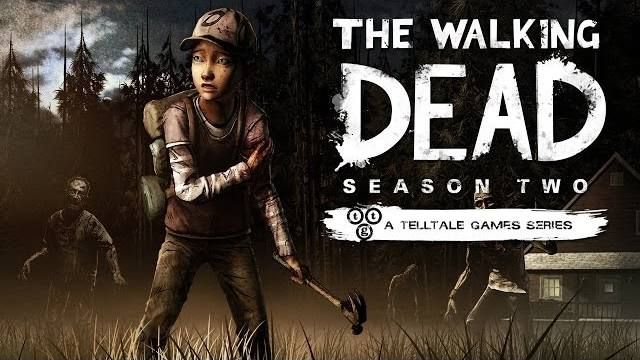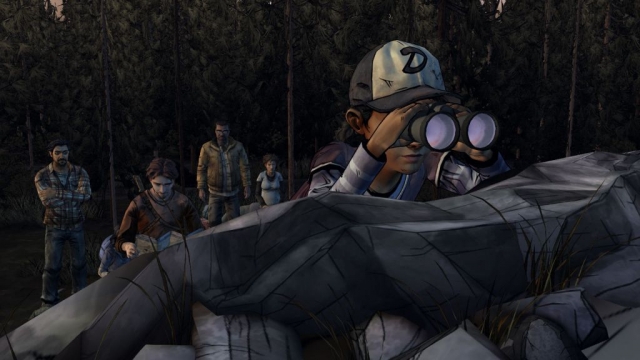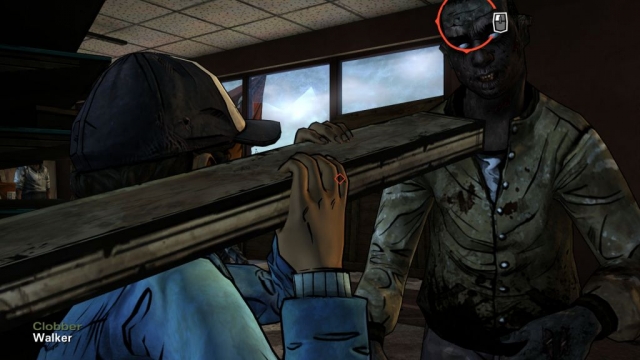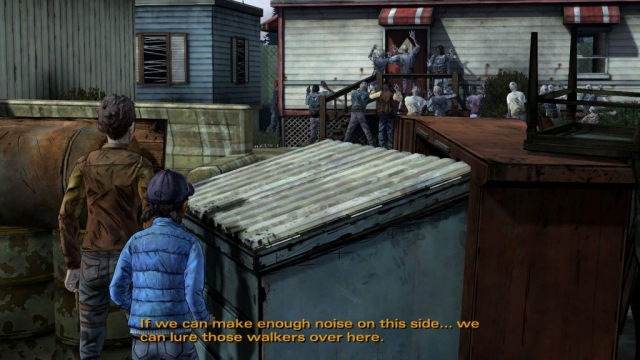The Walking Dead: Season Two

The Walking Dead: Season Two is the follow-up to 2012’s The Walking Dead. It picks up where the first game left off, but since the main character from that game died at the end of the season (along with just about everybody else), you now control a nine-year-old girl named Clementine. After a short introductory sequence during which 16 months pass, Clementine finds herself all alone, but luckily she stumbles upon another group of survivors living in the woods. This group is hiding from somebody named Carver, and since they say his name like he’s Keyser Soze from The Usual Suspects, you know he’s bad news. Soon enough Carver catches up with the group, and things deteriorate from there. Once again, the most dangerous thing about a zombie apocalypse isn’t the zombies — it’s the other survivors.
The engine for Season Two hasn’t changed much since the first game. You move your character with the WASD keys, you use the left mouse button to click on hotspots and talk to other characters, and you use the Q and E keys when you grapple with something (usually a zombie). In the first game you could use the 1-4 keys to select dialogue options, but this isn’t allowed any more, and the context-sensitive menu for choosing actions also changed, but if you played the first game, then you shouldn’t have any trouble jumping into the sequel. About the only new thing with the interface is that you now have to click and drag the mouse sometimes, such as during a gruesome scene early in the game when you have to suture a wound.
Season Two continues developer Telltale Games’ trend of producing interactive movies rather than adventures. There aren’t really any puzzles in the game. Any time you have to solve a problem, there are so few options that you can’t help but complete the task. For example, in the first episode you’re locked in a shed and you have to escape, but there are only about five hotspots total and one inventory object, and so it only takes about five minutes to figure out the solution. Anybody who plays adventure games regularly won’t have any problems, and even more casual gamers should be able to play through without hardship.
Along with the adventure game sequences, Season Two also includes some action sequences where you have to deal with zombies or other threats. Since you’re controlling a young girl, these sequences involve more running and dodging than they did in the first game, but you still find yourself grappling with zombies at least once per episode. The action sequences are about as friendly as they were in the first game. That is, they’re not long or complex, and they’re designed so that even if you don’t play a lot of action games, you can still get through them.
The first season of The Walking Dead worked as an interactive movie, but I had some problems with Season Two. Characters are still developed well, and you still care what happens to them, but there are way too many events that rate way too highly on the implausibility meter — even for a zombie game. For starters, your character does almost the exact same things as the main character from the first game. You mediate disputes, you choose courses of action for your group, you wrestle with zombies, you shake off bullet wounds, and you get blamed when people die. These things all made sense when you were playing a 40-year-old man, but not when you’re playing a pre-teen girl.
There are also some bizarre moments in the game, like when a Russian teen sets up an ambush to rob and / or kill your group. Somehow after the ambush fails, everybody in your group takes the side of the teen against the one person in your group who doesn’t like him, and they’re aghast when he threatens the teen or hits him. I kept waiting for the “shoot Arvo” option, but it never came up. Carver is also a little boring as a villain. He’s just a rabid dog rather than an interesting character, and it’s tough to believe he could hold a group together. For me, the most interesting thing about Carver is that he’s voiced by Michael Madsen, the only “name” actor in the game.
Other parts of Season Two work better. The game looks nice (although I’m starting to recognize some of the zombie faces), the voice acting is once again top-notch, and you’re allowed to import your saved game from the first season — including the 400 Days DLC if you played it — so that the storyline continues smoothly. Plus, the actions you take in the game have at least a minor impact on what happens later, so while Season Two only takes about ten hours to complete, it’s easy to play through it at least twice to see how different decisions create different outcomes.
Overall, I didn’t enjoy The Walking Dead: Season Two as much as I did the first season. The game still works well and has high production values, but the storyline doesn’t make as much sense, especially when everybody — including the zombies — can’t tell the difference between your eleven-year-old character and an adult. Hopefully, if there’s a Season Three and you stick with Clementine, Telltale will jump ahead about five years to make her at least 16. So while I’m not wildly enthusiastic about Season Two, it still has some things going for it, and it’s still likely worthwhile for fans of zombie shows, and since it’s only priced at $25, it receives a passing grade from me.
Reviewed By: Steven Carter
Publisher: Telltale Games
Rating: 78%
——————————————————————————–
This review is based on a digital copy of The Walking Dead: Season Two for the PC provided by Telltale Games.
 Game Over Online
Game Over Online












Totally agree with your review. I also found it odd how much responsibilty I had as an 11-year-old. Even in the zombie apocalypse. Also, I think would have enjoyed it more if I hadn’t played as Clementine herself. That said, I still enjoyed the dramatic ending very much.